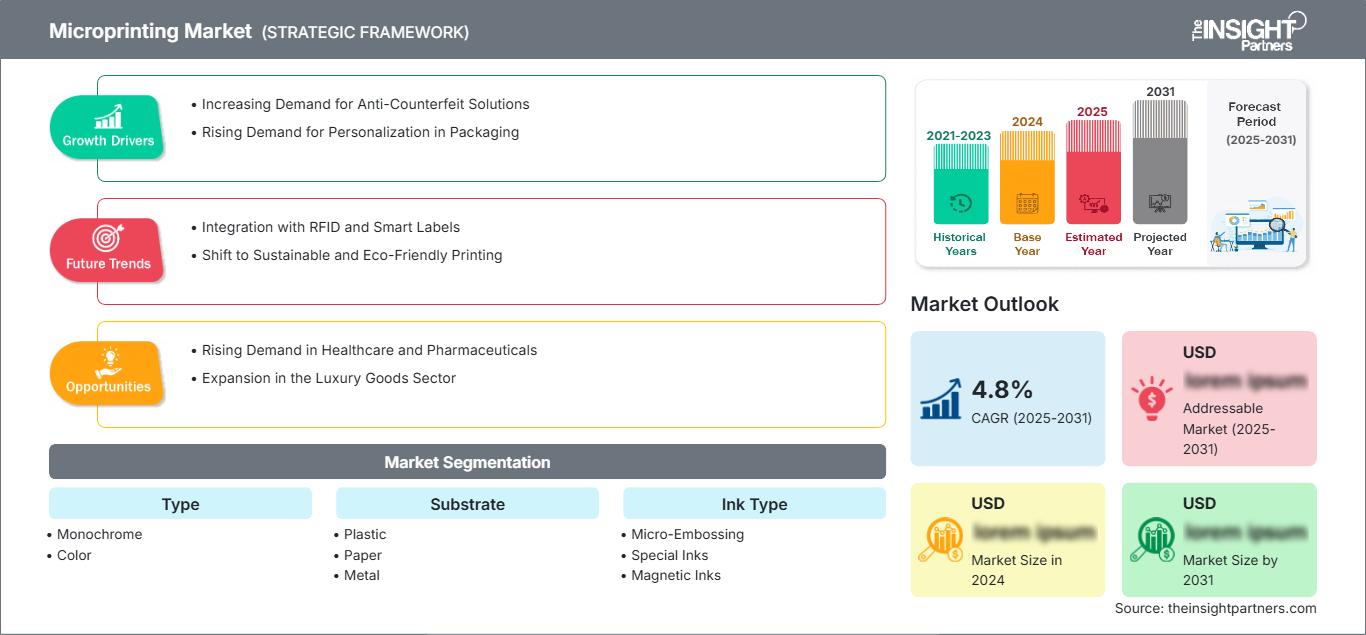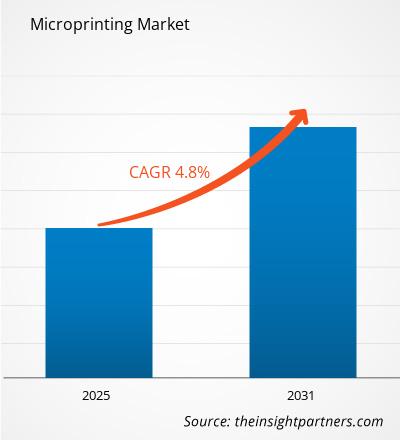Se prevé que el mercado de la microimpresión registre una tasa de crecimiento anual compuesta (TCAC) del 4,8% entre 2025 y 2031, con un tamaño de mercado que se expandirá de XX millones de dólares estadounidenses en 2024 a XX millones de dólares estadounidenses en 2031.
El informe se segmenta por tipo (monocromo, color), sustrato (plástico, papel, metal), tipo de tinta (micrograbado, tintas especiales, tintas magnéticas, tintas UV invisibles, marcas de tinta infrarroja), tipo de impresión (una cara, dos caras) y uso final ( banca , servicios financieros y seguros, gobierno, electrónica de consumo, sanidad, TI y telecomunicaciones, embalaje, otros). El análisis global se desglosa aún más a nivel regional y por países principales. El informe ofrece el valor en USD para el análisis y los segmentos mencionados.
Propósito del Informe
El informe sobre el mercado de la microimpresión, elaborado por The Insight Partners, tiene como objetivo describir el panorama actual y el crecimiento futuro, los principales factores impulsores, los desafíos y las oportunidades. Esto proporcionará información valiosa a diversos actores del sector, tales como:
- Proveedores/fabricantes de tecnología: Para comprender la dinámica cambiante del mercado y conocer las oportunidades potenciales de crecimiento, lo que les permitirá tomar decisiones estratégicas informadas.
- Inversores: Realizar un análisis exhaustivo de las tendencias relativas a la tasa de crecimiento del mercado, las proyecciones financieras del mercado y las oportunidades que existen a lo largo de la cadena de valor.
- Organismos reguladores: Regular las políticas y controlar las actividades en el mercado con el objetivo de minimizar los abusos, preservar la confianza de los inversores y mantener la integridad y la estabilidad del mercado.
Segmentación del mercado de microimpresión
Tipo
- Monocromo
- Color
Sustrato
- Plástico
- Papel
- Metal
Tipo de tinta
- Microestampado
- Tintas especiales
- Tintas magnéticas
- Tintas invisibles UV
- Marcas de tinta infrarroja
Tipo de impresión
- Unilateral
- De dos caras
Uso final
- BFSI
- Gobierno
- Electrónica de consumo
- Cuidado de la salud
- TI y telecomunicaciones
- Embalaje
- Otros
Obtendrá personalización en cualquier informe, sin cargo, incluidas partes de este informe o análisis a nivel de país, paquete de datos de Excel, así como también grandes ofertas y descuentos para empresas emergentes y universidades.
Mercado de la microimpresión: Perspectivas estratégicas

-
Obtenga las principales tendencias clave del mercado de este informe.Esta muestra GRATUITA incluirá análisis de datos, desde tendencias del mercado hasta estimaciones y pronósticos.
Factores que impulsan el crecimiento del mercado de la microimpresión
- Aumento de la demanda de soluciones contra la falsificación: La microimpresión, utilizada en documentos de seguridad, billetes y envases de productos, tiene una demanda creciente para prevenir la falsificación. A medida que sectores como la banca, la farmacéutica y los artículos de lujo buscan envases y documentación seguros, la microimpresión se consolida como una solución líder para combatir el fraude y garantizar la autenticidad de los productos, impulsando así el mercado.
- Aumento de la demanda de personalización en el empaque: La creciente tendencia hacia los empaques personalizados en industrias como la cosmética, la alimentación y bebidas, y el comercio minorista está impulsando el mercado de la microimpresión. La microimpresión ofrece diseños únicos y complejos, incluyendo logotipos de marca personalizados, información del producto y elementos de seguridad, lo que permite a las empresas diferenciar sus productos y mejorar el reconocimiento de marca.
Tendencias futuras del mercado de la microimpresión
- Integración con RFID y etiquetas inteligentes: La integración de la microimpresión con la tecnología RFID (Identificación por Radiofrecuencia) y las etiquetas inteligentes está ganando terreno. La combinación de estas tecnologías mejora la trazabilidad, la seguridad y la lucha contra la falsificación de los productos. Se prevé que esta tendencia se consolide en sectores como la logística, la farmacéutica y la electrónica de consumo.
- Transición a la impresión sostenible y ecológica: La sostenibilidad es una tendencia en auge en la industria de la impresión, con empresas que adoptan materiales y procesos ecológicos en la microimpresión. Los consumidores concienciados con el medio ambiente y las normativas vigentes impulsan a las empresas a utilizar tintas biodegradables y a reducir los residuos, lo que fomenta el desarrollo de soluciones de microimpresión ecológicas.
Oportunidades de mercado en la microimpresión
- Aumento de la demanda en el sector sanitario y farmacéutico: En los sectores sanitario y farmacéutico, la demanda de microimpresión para prevenir la falsificación de medicamentos y garantizar la autenticidad de los productos está en aumento. La oportunidad de mercado en esta industria reside en la aplicación de la microimpresión en etiquetas, envases y precintos de seguridad para mantener la integridad de los productos médicos.
- Expansión en el sector de artículos de lujo: Con el aumento de la demanda mundial de artículos de lujo, la microimpresión desempeña un papel fundamental para garantizar la autenticidad y proteger el valor de la marca. Los mercados de moda, relojería y joyería de alta gama ofrecen importantes oportunidades para la microimpresión, que puede integrarse en el embalaje, las etiquetas y los certificados de autenticidad de los productos.
Perspectivas regionales del mercado de la microimpresión
Los analistas de The Insight Partners han explicado en detalle las tendencias y los factores regionales que influyen en el mercado de la microimpresión durante el período de previsión. Esta sección también analiza los segmentos del mercado de la microimpresión y su distribución geográfica en Norteamérica, Europa, Asia Pacífico, Oriente Medio y África, y Sudamérica y Centroamérica.
Alcance del informe de mercado de microimpresión
| Atributo del informe | Detalles |
|---|---|
| Tamaño del mercado en 2024 | XX millones de dólares estadounidenses |
| Tamaño del mercado en 2031 | XX millones de dólares estadounidenses |
| CAGR global (2025-2031) | 4,8% |
| Datos históricos | 2021-2023 |
| período de previsión | 2025-2031 |
| Segmentos cubiertos |
Por tipo
|
| Regiones y países cubiertos |
América del norte
|
| Líderes del mercado y perfiles de empresas clave |
|
Densidad de los actores del mercado de la microimpresión: comprensión de su impacto en la dinámica empresarial
El mercado de la microimpresión está creciendo rápidamente, impulsado por la creciente demanda de los usuarios finales debido a factores como la evolución de las preferencias de los consumidores, los avances tecnológicos y una mayor conciencia de los beneficios del producto. A medida que aumenta la demanda, las empresas amplían su oferta, innovan para satisfacer las necesidades de los consumidores y aprovechan las nuevas tendencias, lo que impulsa aún más el crecimiento del mercado.

- Obtenga una visión general de los principales actores del mercado de la microimpresión.
Puntos clave de venta
- Cobertura integral: El informe abarca de forma exhaustiva el análisis de productos, servicios, tipos y usuarios finales del mercado de la microimpresión, proporcionando una visión holística.
- Análisis de expertos: El informe se elabora a partir del profundo conocimiento de expertos y analistas del sector.
- Información actualizada: El informe asegura relevancia comercial debido a su cobertura de información reciente y tendencias de datos.
- Opciones de personalización: Este informe se puede personalizar para satisfacer las necesidades específicas del cliente y adaptarse adecuadamente a las estrategias comerciales.
Por lo tanto, el informe de investigación sobre el mercado de la microimpresión puede ayudar a impulsar la comprensión del panorama de la industria y sus perspectivas de crecimiento. Si bien existen algunas preocupaciones válidas, los beneficios generales de este informe tienden a superar las desventajas.
- Análisis histórico (2 años), año base, pronóstico (7 años) con CAGR
- Análisis PEST y FODA
- Tamaño del mercado, valor/volumen: global, regional y nacional
- Industria y panorama competitivo
- Conjunto de datos de Excel
Informes recientes
Informes relacionados
Testimonios
Razón para comprar
- Toma de decisiones informada
- Comprensión de la dinámica del mercado
- Análisis competitivo
- Información sobre clientes
- Pronósticos del mercado
- Mitigación de riesgos
- Planificación estratégica
- Justificación de la inversión
- Identificación de mercados emergentes
- Mejora de las estrategias de marketing
- Impulso de la eficiencia operativa
- Alineación con las tendencias regulatorias






















 Obtenga una muestra gratuita para - Mercado de la microimpresión
Obtenga una muestra gratuita para - Mercado de la microimpresión